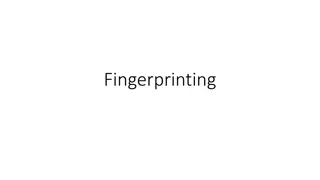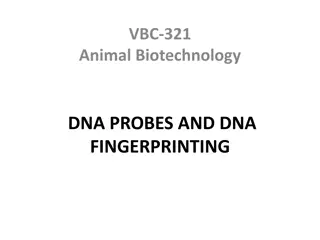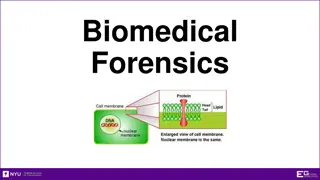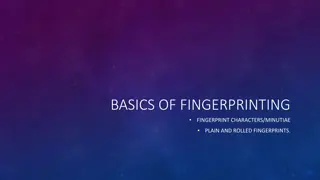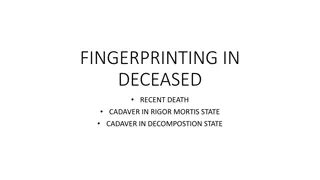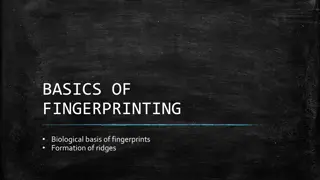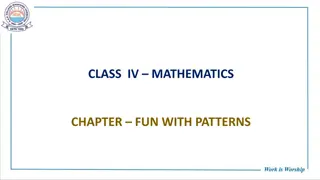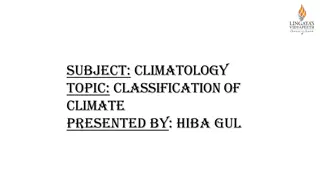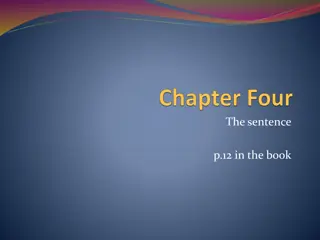Understanding Fingerprinting: Types, Classification, and Patterns
Fingerprinting is the oldest and reliable method of identifying individuals based on unique patterns on their fingertips. This article explores the definition of fingerprints, reasons for using them, classification methods, and the three main types of fingerprint patterns: Loop, Whorl, and Arch. Each pattern has distinct characteristics that aid in forensic identification.
Download Presentation

Please find below an Image/Link to download the presentation.
The content on the website is provided AS IS for your information and personal use only. It may not be sold, licensed, or shared on other websites without obtaining consent from the author. Download presentation by click this link. If you encounter any issues during the download, it is possible that the publisher has removed the file from their server.
E N D
Presentation Transcript
Performance Objectives Refer to the POST Goal and Objectives
Definition of Fingerprint Fingerprint- The impression or mark left by the underside of the tips of the fingers or thumbs. The impression is formed by a pattern of ridges on the skin surface. This pattern is unique for each individual and therefore can serve as a means of identification. Retrieved from www.dictionary.com ; 11/5/2016 @1:49 PM
Why do we do it? It is the oldest and generally considered one of the most reliable means of identifying a person. Each person finger prints are unique to them.
Classification Classification of fingerprints involves giving each recorded fingerprint on a ten print fingerprint card a proper classification with a corresponding sub- classification or ridge count, and then using those classifications for each print in a classification formula. Two methods of classification; NCIC and Henry
Three Type of Fingerprint Patterns Loop Whorl Arch
Loop In a Loop pattern, the ridges will flow in one side, recurve, (loop around) touch or pass through an imaginary line drawn from the delta to the core, and exit the pattern on the same side as it entered. *A loop pattern has only one delta. *There are two types of loop patterns: 1. Ulnar loop 2. Radial loop *Loop patterns account for @ 70% of all fingerprints
Whorl form circular or spiral patterns, like tiny whirlpools. There are four groups of whorls: 1. Plain (concentric circles), 2. Central pocket loop (a loop with a whorl at the end), 3. Double loop (two loops that create an S-like pattern) 4. Accidental loop (irregular shaped). *Whorl patterns account for @ 35% of all fingerprints
Arch In an arch pattern, ridges flow in one side and flow out the opposite side. There are no deltas in an arch pattern. *There are two types of arch patterns: 1. Plain arch, 2. Tented arch Arch patterns account for @ 5% of all fingerprints
Delta-explained The point on a ridge at or in front of and nearest the center of the divergence of the type lines. The delta area is located as a triangular area where the ridges radiate outward in three directions
FRICTION RIDGE Fingerprints Palm Prints Barefoot Impressions
FRICTION RIDGE IMPRESSIONS PATENT/VISABLE PLASTIC LATENT
PATENT/VISABLE PRINT Friction ridges that are stained with a foreign colored substance, such as blood, ink, grease or dirt. This makes a visible impression that can be seen with the naked eye.
PLASTIC PRINT An indentation into a soft substrate such as chewing gum, wax, soap, putty, tar, butter or clay, fresh paint which leaves a three- dimensional impression. This makes a visible impression that can be seen with the naked eye.
IMPRESSION EVIDENCE Formed when one object is pressed against another material. Footprints Tire Tracks Bite Marks Tool Marks.
LATENT PRINT Fingerprint impressions secreted on a surface or object. Latent prints are usually invisible to the naked eye. Made by sweat and oil on the skin surface.
DEVELOPING FINGERPRINTS Nonporous Surfaces Glass Marble Metal Plastic Finished Wood Light Powder Superglue Fuming Porous Surfaces Fabric Paper Un-Finished Wood Iodine Fuming Silver Nitrate Ninhydrin
DUSTING FOR FINGERPRINTS Select an appropriate powder and brush Fan the brush Dip fan tips in SMALL amount of powder Fan off excess powder Dust area with gentle strokes or light spinning of the brush
LIFTING THE PRINT Use Clear Plastic Tape Apply end of tape away from print and carefully smooth out over print Lift the tape Place tape on a backing card Document necessary information on backing card
LABORATORY TESTING Blood Items to be tested for DNA Known DNA samples Firearms Porous materials (paper, unfinished wood, cardboard, etc.)
WESTERN IDENTIFICATION NETWORK AUTOMATED FINGERPRINTING IDENTIFICATION SYSTEM WIN / AFIS WIN / AFIS
National Crime Information Center Computerized Index of Documented Criminal Justice Information Over 20 Files of Information Available 24 hours a day 365 days a year
PRACTICAL EXERCISE
ROLLING FINGERPRINTS
ROLLING INKED PRINTS Roll the finger on the ink so the entire pad is covered nail to nail Thumb is rolled towards the subject s body (1st Digit rolled) Fingers are rolled away from the subject s body (Order - Index, Middle, Ring, Little finger) Plain Impressions done last (4 fingers 1st, then thumbs)
FINGERPRINT CARD An example of clean rolled prints. The purpose for the simultaneous prints is to establish natural spacing
SPECIAL CIRCUMSTANCES Deformed or Missing Fingers Fully Amputated Tip-Amputated Extra Finger Scarred Fingers Worn Fingerprints
Finger was not fully rolled Allowing the fingers to slip or twist Use of improper inks Failure to clean the subject s fingers Failure to keep equipment clean Use of too much or too little ink Recording fingerprints impressions within the wrong blocks on the print card REASONS FOR REJECTION



